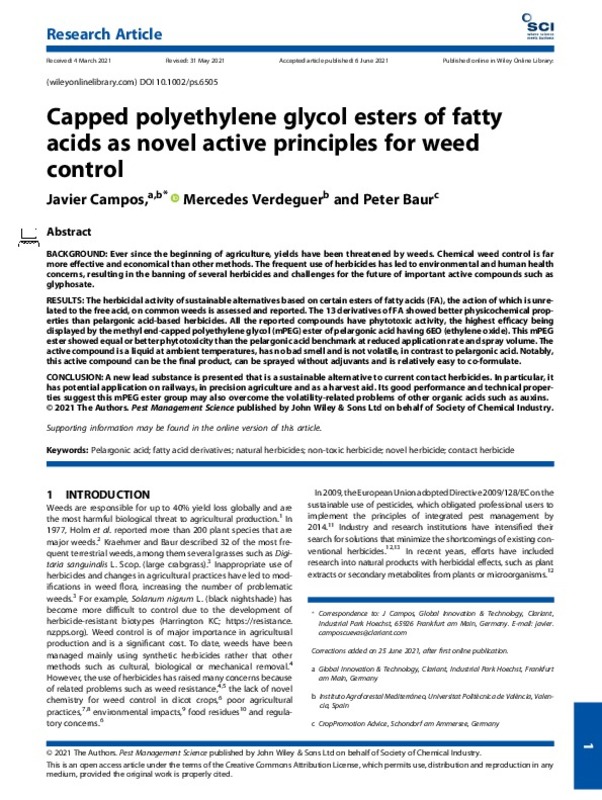JavaScript is disabled for your browser. Some features of this site may not work without it.
Buscar en RiuNet
Listar
Mi cuenta
Estadísticas
Ayuda RiuNet
Admin. UPV
Capped polyethylene glycol esters of fatty acids as novel active principles for weed control
Mostrar el registro sencillo del ítem
Ficheros en el ítem
| dc.contributor.author | Campos, Javier
|
es_ES |
| dc.contributor.author | Verdeguer Sancho, Mercedes María
|
es_ES |
| dc.contributor.author | Baur, Peter
|
es_ES |
| dc.date.accessioned | 2022-04-27T06:28:18Z | |
| dc.date.available | 2022-04-27T06:28:18Z | |
| dc.date.issued | 2021-10 | es_ES |
| dc.identifier.issn | 1526-498X | es_ES |
| dc.identifier.uri | http://hdl.handle.net/10251/182148 | |
| dc.description.abstract | [EN] BACKGROUND Ever since the beginning of agriculture, yields have been threatened by weeds. Chemical weed control is far more effective and economical than other methods. The frequent use of herbicides has led to environmental and human health concerns, resulting in the banning of several herbicides and challenges for the future of important active compounds such as glyphosate. RESULTS The herbicidal activity of sustainable alternatives based on certain esters of fatty acids (FA), the action of which is unrelated to the free acid, on common weeds is assessed and reported. The 13 derivatives of FA showed better physicochemical properties than pelargonic acid-based herbicides. All the reported compounds have phytotoxic activity, the highest efficacy being displayed by the methyl end-capped polyethylene glycol (mPEG) ester of pelargonic acid having 6EO (ethylene oxide). This mPEG ester showed equal or better phytotoxicity than the pelargonic acid benchmark at reduced application rate and spray volume. The active compound is a liquid at ambient temperatures, has no bad smell and is not volatile, in contrast to pelargonic acid. Notably, this active compound can be the final product, can be sprayed without adjuvants and is relatively easy to co-formulate. CONCLUSION A new lead substance is presented that is a sustainable alternative to current contact herbicides. In particular, it has potential application on railways, in precision agriculture and as a harvest aid. Its good performance and technical properties suggest this mPEG ester group may also overcome the volatility-related problems of other organic acids such as auxins. | es_ES |
| dc.language | Inglés | es_ES |
| dc.publisher | John Wiley & Sons | es_ES |
| dc.relation.ispartof | Pest Management Science | es_ES |
| dc.rights | Reconocimiento (by) | es_ES |
| dc.subject | Pelargonic acid | es_ES |
| dc.subject | Fatty acid derivatives | es_ES |
| dc.subject | Natural herbicides | es_ES |
| dc.subject | Non-toxic herbicide | es_ES |
| dc.subject | Novel herbicide | es_ES |
| dc.subject | Contact herbicide | es_ES |
| dc.subject.classification | BOTANICA | es_ES |
| dc.title | Capped polyethylene glycol esters of fatty acids as novel active principles for weed control | es_ES |
| dc.type | Artículo | es_ES |
| dc.identifier.doi | 10.1002/ps.6505 | es_ES |
| dc.rights.accessRights | Abierto | es_ES |
| dc.contributor.affiliation | Universitat Politècnica de València. Departamento de Ecosistemas Agroforestales - Departament d'Ecosistemes Agroforestals | es_ES |
| dc.description.bibliographicCitation | Campos, J.; Verdeguer Sancho, MM.; Baur, P. (2021). Capped polyethylene glycol esters of fatty acids as novel active principles for weed control. Pest Management Science. 77(10):4648-4657. https://doi.org/10.1002/ps.6505 | es_ES |
| dc.description.accrualMethod | S | es_ES |
| dc.relation.publisherversion | https://doi.org/10.1002/ps.6505 | es_ES |
| dc.description.upvformatpinicio | 4648 | es_ES |
| dc.description.upvformatpfin | 4657 | es_ES |
| dc.type.version | info:eu-repo/semantics/publishedVersion | es_ES |
| dc.description.volume | 77 | es_ES |
| dc.description.issue | 10 | es_ES |
| dc.identifier.pmid | 34092022 | es_ES |
| dc.relation.pasarela | S\442781 | es_ES |
| dc.subject.ods | 02.- Poner fin al hambre, conseguir la seguridad alimentaria y una mejor nutrición, y promover la agricultura sostenible | es_ES |
| dc.subject.ods | 15.- Proteger, restaurar y promover la utilización sostenible de los ecosistemas terrestres, gestionar de manera sostenible los bosques, combatir la desertificación y detener y revertir la degradación de la tierra, y frenar la pérdida de diversidad biológica | es_ES |








